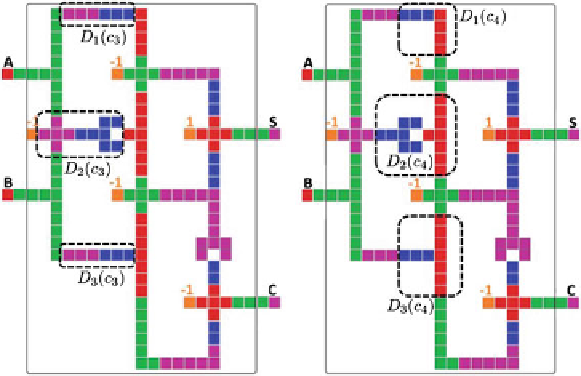Information Technology Reference
In-Depth Information
Fig. 3.
Data subzones comprising data zones
D
(
c
3
)(left)and
D
(
c
4
) (right), which
are the circuit regions holding input information at the conclusion of the third and
fourth computational steps, respectively. Computational step
c
4
is one of the steps
that unavoidably suffers irreversible information loss resulting energy dissipation.
in one computational cycle of the QCA half adder is the sum of contributions
from each step
11
11
Δ↕E
B
≤
k
ΔE
diss
=
ΔE
diss
(
c
k
)=
(4)
k
=1
k
=1
where
Δ↕E
B
≤
k
during the
control phase of the
k
th
computational step
c
k
. Under paradigmatic operation,
our analysis reveals that only computational steps
c
4
,
c
6
and
c
8
are dissipative.
This dissipation is a result of irreversible loss of input information from asso-
ciated clock subzones that occur as the data zones evolve during these steps.
Physical-information-theoretic evaluation of the corresponding single-step lower
bounds on
Δ↕E
B
≤
k
is the change in the expected energy of the bath
B
for the dissipative steps via Eq. (
2
) yields
Δ↕E
B
≤
4
≥
1
.
19
k
B
T
ln(2)
Δ↕E
B
≤
6
≥
1
.
38
k
B
T
ln(2)
Δ↕E
B
≤
8
≥
1
.
19
k
B
T
ln(2)
.
The resulting lower bound on the dissipative cost of one computational cycle in
the Landauer-clocked QCA half adder is then
ΔE
diss
≥
(3
.
76)
k
B
T
ln(2)
.
(5)
This full-cycle bound is about 7
.
5
the 0
.
5
k
B
T
ln(2) lower bound for any half
adder that erases its input, with the excess irreversibility resulting from locality
×

Search WWH ::

Custom Search